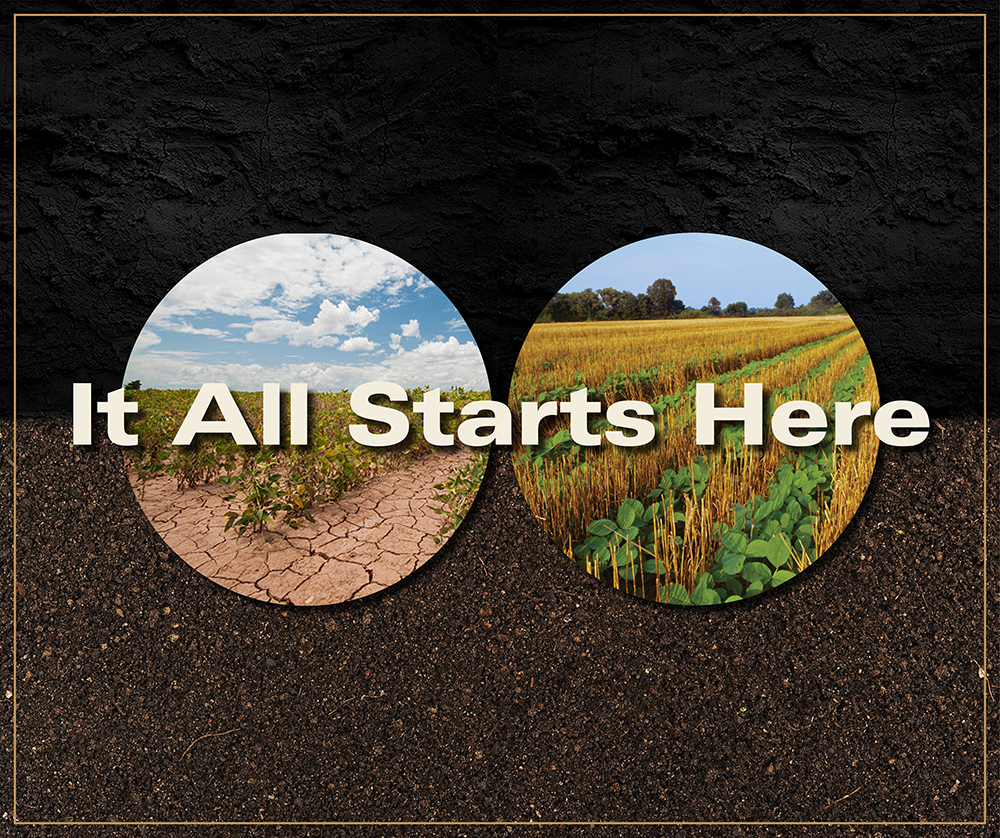Enriching Soil, Enhancing Life

Farmers, ranchers and other agribusiness professionals have the privilege of celebrating Earth Day every day.
On Earth Day 2018, we are both challenged and excited. We look forward to seeing what we’ll all accomplish together!
WHAT IS SOIL ORGANIC MATTER?
Decaying material, mostly from plants, makes up about 85% of all carbon-containing organic matter in our soils. This material includes everything from lawn trimmings to crop residue to animal manures. Roots, microbes and other decaying biological materials contribute a lot, too.
WHY IS SOIL ORGANIC MATTER SO IMPORTANT?
A stable, high level of organic matter in our soil gives us multiple rewards. Biologically, organic matter serves as a nutrient supermarket for living soil organisms and helps suppress diseases and pests by stimulating the soil’s microbial activity and diversity.
Soil organic matter physically improves our soil in a lot of different ways. Did you know soil can be a great water filter and serve as a gigantic rain barrel at the same time? And that these benefits are enhanced by soil organic matter?
What Does Organic Matter Contribute to Our Soil?
- Holds soil together
- Stores and helps recycle important nutrients that keep us healthy
- Improves soil’s ability to store water
- Improves the movement of air, nutrients, and water down through the soil to the plant roots
- Stores carbon that was captured from the atmosphere by plant photosynthesis and makes it available as food for microorganisms, which then recycle the other nutrients for plants, animals and humans
- Reduces runoff and erosion, protecting our streams, rivers, lakes and oceans
- Cleans up our water and helps filter numerous pollutants, including heavy metals
HEALTHY SOIL AND HEALTHY PEOPLE…. ARE THEY CONNECTED?
Microbes that cause many diseases in humans spend a lot of their time hanging around in soil, waiting for their next host. For example, we know that at least 300 out of more than 100,000 species of soil fungi cause disease in humans. (Source: Bultman et al. 2005) Some pathogens are even favored by unhealthy soil and soil under drought stress, such as Valley Fever, Cholera, and Fungal Meningitis.
There are many other ways that soil health and human health are connected:
- Soil health influences the nutrient composition of crops that make up many of the foods we eat.
- Soil health influences the movement and survival of microbes that can be a hazard to food safety.
- Soil health influences which microbes inhabit our digestive system and affect how we absorb nutrients from food.
- Soil health influences the quality of the water we drink and the air we breathe.
So here’s to our soil…..not just something to walk on, but something that helps keep us healthy!
SOIL’S AN ANTIBIOTIC GOLD MINE
Bacteria and fungi found in soil make many of the antibiotics you’ve taken to cure infections, like penicillin, streptomycin, actinomycin, neomycin, and vancomycin. And now, there’s an antibiotic-resistant-bacteria-battling drug that was generated from a Maine soil sample. Called teixobactin, this antibiotic kills methicillin-resistant staphylococcus aureus (MRSA) and mycobacterium tuberculosis! (Source: Nature 2015)
It’s exciting to realize there are up to 1 billion bacterial cells in each gram (think a quarter of a teaspoon) of soil. (Source: Journal of Soil and Water Conservation.) To date, we’ve cataloged only about 1% of all soil microorganisms – fungi, protozoa, bacteria…. That means, we’re just starting to unlock the potential impact of healthy soil on people’s health.
HEALTHY SOIL DELIVERS IMPORTANT, HEALTHY NUTRIENTS
Did you know about 815 million people (11% of the world’s population in 2016) are considered under-nourished? (Source: Food and Agriculture Organization of the United Nations.)
Yet 18 elements considered essential for life are obtained from the soil underneath our farms and ranches. (Sources: Brevik 2013a, Nature Education 2014). Agricultural experts are working to increase the plant uptake of these important earthly elements. Plant breeding and soil management improvements may help us produce up to 50% more food in the future. And, we’re working to strengthen the nutritional value of our food, too. (Source: Food and Agriculture Organization of the United Nations.)
SOIL CAN BE OUR #1 DROUGHT SHIELD
We can build up our soil and, as a result, water our lawns, gardens and farm fields less often!
Healthy soil that has a lot of organic matter can store up to 20x its weight in water. (Source: Food and Agriculture Organization.)
If a soil with low organic matter content can get just another 1% of its weight in those carbon-containing substances from crop debris, animal manure, etc., in the top 6 inches of soil, we increase the volume of water stored by up to 27,000 gallons an acre! (Source: USDA-NRCS.) Based on climate data for the northeastern U.S., the probability of having an 8-day dry period is only 1 in 20 (5%), so imagine the impact of 27,000 gallons of water held in an acre-wide soil sponge! (Source: Sustainable Agriculture Research & Education (SARE)). One long-term experiment showed that reducing tillage and using crop rotations increased plant-available soil-stored water by up to 34%. (Source: Moebius et al. (2008).
Soil organic matter……won’t make it rain, but it sure helps the soil hold on to the rain it gets!